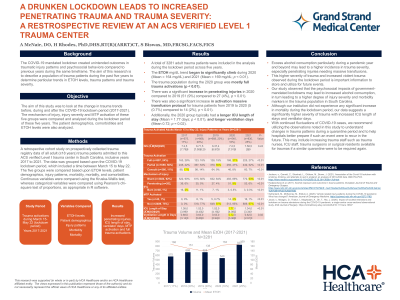Trauma
Category: Quickshot Oral Session 06
Quickshot Oral : Quickshot Oral Session 06
A DRUNKEN LOCKDOWN LEADS TO INCREASED PENETRATING TRAUMA AND TRAUMA SEVERITY: A RESTROSPECTIVE REVIEW AT AN ACS VERIFIED LEVEL 1 TRAUMA CENTER
Saturday, February 11, 2023
3:00pm - 4:00pm East Coast USA Time

- AM
Adina McNair, DO
Resident
Grand Strand Medical Center, United States - AM
Adina McNair, DO
Resident
Grand Strand Medical Center, United States
Presenter(s)
Principal Contact(s)
Objectives: The COVID-19 mandated lockdown created unintended outcomes in traumatic injury patterns and psychosocial behaviors compared to previous years during the same timeframe. The aim of this research is to describe a population of trauma patients during the past five years to determine particular trends in ETOH levels, trauma patterns and trauma severity.
Methods: A retrospective cohort study on prospectively collected trauma registry data of all adult (≥18 years) trauma patients admitted to this ACS verified Level I trauma center in South Carolina, inclusive years 2017 to 2021. The data was grouped based upon the COVID-19 lockdown period, which included a time between March 15 to May 22. The five groups were compared based upon ETOH levels, patient demographics, injury patterns, morbidity, mortality, and comorbidities. Continuous variables were compared using the Kruska-Wallis test, whereas categorical variables were compared using Pearson's chi-square test of proportions, as appropriate in R software.
Results: A total of 3281 adult trauma patients were included in the analysis during the lockdown period across five years. The ETOH mg/dL trend was initially declining from 2017-2019 with a mean 138 mg/dL in 2019; however, began to significantly climb during 2020 (Mean = 164 mg/dL) and 2021 (Mean = 169 mg/dL; p < 0.01). The trauma population during the 2020 group was mostly full trauma activations (p < 0.01). There was a significant increase in penetrating injuries in 2020 compared to 2019 (51 (9%) compared to 27 (4%), p < 0.01). There was also a significant increase in activation massive transfusion protocol for trauma patients from 2019 to 2020 (5 (0.7%) compared to 14 (2%), p < 0.01). Additionally, the 2020 group typically had a longer ICU length of stay (Mean = 1.77 days; p < 0.01), and longer ventilation days (Mean 0.72; p = 0.02).
Conclusion: Excess alcohol consumption particularly during a pandemic year and beyond may lead to a higher incidence in trauma severity, especially penetrating injuries needing massive transfusions. The psychosocial impacts of government-mandated lockdowns may lead to increased alcohol consumption leading to a higher degree of injury severity and morbidity markers in the trauma population in South Carolina.
Methods: A retrospective cohort study on prospectively collected trauma registry data of all adult (≥18 years) trauma patients admitted to this ACS verified Level I trauma center in South Carolina, inclusive years 2017 to 2021. The data was grouped based upon the COVID-19 lockdown period, which included a time between March 15 to May 22. The five groups were compared based upon ETOH levels, patient demographics, injury patterns, morbidity, mortality, and comorbidities. Continuous variables were compared using the Kruska-Wallis test, whereas categorical variables were compared using Pearson's chi-square test of proportions, as appropriate in R software.
Results: A total of 3281 adult trauma patients were included in the analysis during the lockdown period across five years. The ETOH mg/dL trend was initially declining from 2017-2019 with a mean 138 mg/dL in 2019; however, began to significantly climb during 2020 (Mean = 164 mg/dL) and 2021 (Mean = 169 mg/dL; p < 0.01). The trauma population during the 2020 group was mostly full trauma activations (p < 0.01). There was a significant increase in penetrating injuries in 2020 compared to 2019 (51 (9%) compared to 27 (4%), p < 0.01). There was also a significant increase in activation massive transfusion protocol for trauma patients from 2019 to 2020 (5 (0.7%) compared to 14 (2%), p < 0.01). Additionally, the 2020 group typically had a longer ICU length of stay (Mean = 1.77 days; p < 0.01), and longer ventilation days (Mean 0.72; p = 0.02).
Conclusion: Excess alcohol consumption particularly during a pandemic year and beyond may lead to a higher incidence in trauma severity, especially penetrating injuries needing massive transfusions. The psychosocial impacts of government-mandated lockdowns may lead to increased alcohol consumption leading to a higher degree of injury severity and morbidity markers in the trauma population in South Carolina.

